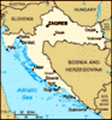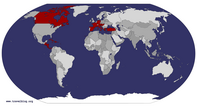Advertisement
Published: April 15th 2015
Travelling down to the tip of the Istrian region to the port town of Pula was on the top of our list yesterday. We drove first to the small village of Bale, a quiet picturesque place with the Soardo-Bembo Castle built between two towers. These, along wth the town gates and fortifications all date back to the Middle Ages. We were virtually alone in this timy hamlet with a handful of cafes and locals going about their daily routines.
We drove further down until we reached Pula, Istria's biggest city. It is a busy port but also has some of Croatia's top Roman ruins. This city has long been the centre of trade, industry, and military strength and in 177 B.C. it became an integral outpost of the Roman Empire. Pula was destroyed following Julius Caesar's death and later re-built by Emperor Augustus. Pula has several Roman ruins that date back to the early 1st century A.D. When Rome fell, so did Pula and it eventually became caught in the middle of several wars between great powers and in the 14th century was taken down by Genoa. It wasn't until the mid 19th century that Pula began to thrive again
when the Austrian Habsburgs moved their navy fleet here.
As we pulled into the parking lot we were in awe of the huge Roman Amphitheatre that towered before us. It is the the 6th largest and best preserved anywhere. In Roman times gladiator fights were very common. The ampitheatre would seat more than 25000 fans all in the pursuit of seeing blood being shed. People from all social classes came to these fights, which were often cheap or free. The field was covered in sand to absorb the blood that came out of man and beast. We climbed up and sat ion the stone seats and then down to the arena floor where Curtis insisted on having a little gladiator fight Of our own! Next it was down below the arena to the section where the gladiators and animals were kept between fights. Now it is an exhibition of ancient wine and olive oil machinery and amphorae, tall and skinny ceramic jugs that were used to store and carry both wine and oil.
We wandered into the old town, stopping in to the Katedrala (Catherdral) which dates back to the 5th century A.D. with a bell tower beside
it (thank goodness there was no opportunity to climb it!). The inside of the church was far different from others we have visited as it was very plain in appearance. Carrying on, we then came to the main square, a common feature in every Roman town. The main square in Pula is called, the Forum which is now filled with restaurants lining the perimeter. On one end of this square is the Temple of Augustus which was built during the reign of and also dedicated to Augustus Caesar. During World War II this temple took a direct hit from an Allied bomb and after the war the Allied occupiers attempted to re-build it. There were three at one time in this square, but ony one remains. Unfortunately we could not get inside as it does not open until May.
While in Pula we found the Basilica of St. Mary Formoza, a small chapel that once stood in the field with a vast basilica. Walking through the Arch of Sergius was reminiscent of being in the Roman Forum in Rome. This large arch marked the edge of the Roman town. We also saw the statue of James Joyce at the
Cafe Uliks. He moved here from Dublin with his girlfriend, teaching English to naval officers and penned the short stories that would later be published as the Dubliners. We wandered through the huge market in the National Square. After looking forever, we finally came across the small Roman Theatre that was away from the more congested part of the old town. The remains of this ancient theatre still has part of its stage intact and several rows of the seats remain. We then followed a small path around to Fort Kastel which houses the Historical Museum of Istria.
Leaving Pula we made our way to a grocery store to pick up a couple of items for dinner. After setting my items on the conveyor I put my basket on the floor beside me. Suddenly the girl at the till broke into a torrent of Croation. I didn't realize she was talking to me, so she started over again. There was a nice man behind me who must have noticed my confusion (or just knew I was a foreigner) as he gently tapped my shoulder and pointed at my basket. He then motioned that I was to move it to
the end of the line. I smiled and thanked him! I love when people take the time to help instead of becoming frustrated with you.
Soon we arrived back in Rovinj where my driver needed a quick nap. After some shut-eye we headed into town as I wanted to pick up some Croatian handmade earrings (I lost the pair I brought from home😞. On our way down we met our host's mother, Maria, who had taken us in on our first day. The look of joy on her face when she recognized us was worth a million dollars. She grabbed my hand and pointed at my bare arms, concerned I may be cold (its was 23 degrees here today and locals are stills wearing winter coats). I assured her I was warm enough. As we made our way up the slippery stones to the shops below the church, there was one man who was in front of his very tiny store. He had some beautiful necklaces hanging up. He greeted me "Guten Tag," and I replied in kind. Then he broke into a lengthy dissertation about his jewellry, all in German! He was enthusiastically explaining the different styles and
I just listened patiently, nodding when I figured it was appropriate. When he finished I said, "Thank you". He just looked at me in surprise and said, "English, nichts Deutsch?". I just smiled and he put his arm around me and broke into laughter. He apologized and said that if I had said, "Dohber Dahn he would have explained everything in Croatian!". So then I listened to the English version. I was getting the deal of the day because it was off-season. Regularly 200 kunas, now 75! I told him I may come back. He said, "Okay, bye-bye". With a grin I said, "Auf Wiedersehen." He guffawed loudly and patted me on the back. I then went up to meet Curtis who had watching this exchange from afar. I told him he should have been there as it would have been a great opportunity to practise his German!
We made our way up to the top and after a last glimpse of the Tower of Terror and the beautiful vista from the church we headed back down. The same man spoke to Curtis and then grinned broadly as I followed behind. I told him my husband was learning German
so he got the explanation too! Curtis tried hard to understand all he was saying but this lovely man was speaking quite fast. After all was said and done I walked away with one of his necklaces for 70 kunas!
As we strolled along the water we remarked how much we love Rovinj. All the places we have seen in Istria are incredibly beautiful, and each one unique, but there is something special about this place. Somehow it still manages to keep that small town charm and feel. On our way to our street we passed a very large wine barrel. We knew that the house beyond it had something to do with wine production. Ever curious, Curtis popped his head into the barely open door where upon he met a wonderful lady who tried in vain to communicate in a mix of English and German. She produces Malvasia wine, which a well-known white wine of this region. We sipped a delicious sample and then tried to figure out where we would buy this wine. As we stood there an older couple came in, laden with plastic pop bottles. Finally through gesturing and the odd word we figured out
that if we bring our own bottle, she will fill it with wine!! So home we raced, emptied and rinsed out the Fanta bottle from our fridge and 15 minutes later we were the proud owners of delicious Istrian white wine in a pop bottle !!! It's these little adventures that make each day memorable.
Tuesday morning we packed our bags and cleaned up the apartment. We were so thankful that we did not have to lug our backbacks to a train or bus station! As we got ready to head out Curtis knocked on Maria and Paul's door to say good-bye. Maria came out and drew me into a wonderfully warm hug, kissing me about 10 times on the cheek. We held hands, she went on in her language and I in mine, but we both knew what the other was expressing. It was such wonderful good-bye from a special lady and it left me feeling that I had made a friend.
We then began our journey to Crikvenica (Srikveneetsa)! Travelling down the coastal road was indeed an adventure of epic beauty! As we made our way from Rovinj to the other side of Istris we were
treated to sights and heights that defied imagination. The twists and turns in the road were met with skill by my husband while I slammed on the brakes on my side and clenched the door handle. The vista was amazing as I looked down the huge mountains to where beautiful houses were nestled in far below at the water's edge. We travelled through a number of coastal towns, some big, others small. Soon we came to Crikvenica which is a small beach town. We found our way to Hotel Kastel. This hotel is unique and rich in history as it used to be one of the main sights in town, the Frankopan Castle. It was built in 1412 by Count Nikola Frankopan and is considered one of the founding buildings of Crikvenica. Through the years it has had different uses. It was a monastery, a convalescent home for soldiers, and a children's home. Today it is a beautiful hotel where we can relax and re-charge our batteries for our busy travel days a week from now.
We walked along the Crikvenica Riviera, enjoying the sunshine. This riviera is the sunniest in all of Europe. Locals were out in force
as they leave their hillside houses to come down to the large, open square where older men gather to exchange gossip on benches and children whizz around on their scooters. Later we walked out to a pier to watch as the sun set over the mountains.
Advertisement
Tot: 0.141s; Tpl: 0.012s; cc: 14; qc: 62; dbt: 0.0756s; 1; m:domysql w:travelblog (10.17.0.13); sld: 1;
; mem: 1.2mb













